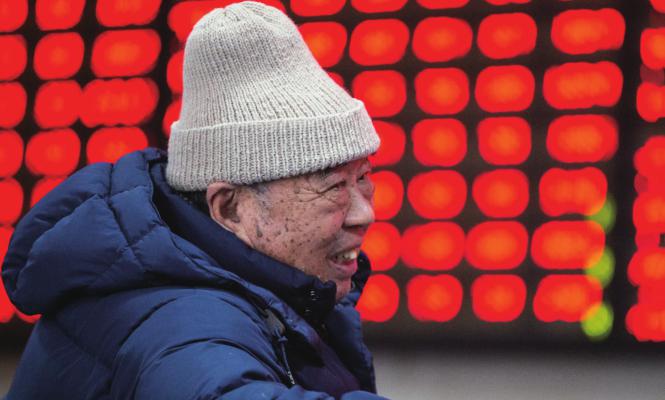Curbing Risks
2019-03-10ByZhangShasha
By Zhang Shasha

The Peoples Bank of China (PBC), the central bank, has set up a macro-prudential management bureau to enhance oversight of financial stability and systemic risks, according to a statement issued by the State Commission Offi ce for Public Sector Reform on February 2.
The new bureau is responsible to formulate macro-prudential policies, evaluate important fi nancial agencies, outline rules and regulations, and monitor fi nancial risks, the statement said. Its role also includes assessing foreign exchange policies and promoting the yuans cross-border transactions.
After the 19th National Congress of the Communist Party of China (CPC) in 2017 decided to “improve the framework of regulation underpinned by monetary policy and macroprudential policy,” the bureau is an important step to improve the framework following the establishment of the Financial Stability and Development Committee under the State Council, Chinas cabinet, in 2017.
Coping with risks
Taking tough steps to forestall and defuse major risks has become a crucial task. Both the 19th CPC National Congress and the Central Economic Work Conference, the annual meeting held in December 2018 to formulate economic policies for 2019, emphasized the task.
A nations core competitiveness lies in its fi nance, which is an important tool for macrocontrol. Financial security is an integral part of national security, laying a solid foundation for stable and healthy economic development, Yin Yong, Vice Mayor of Beijing, said at a forum in December 2018. Yin was deputy governor of the PBC between December 2016 and January 2018.
While some progress has been made, more efforts are needed to curb fi nancial risks in 2019 amid growing downward economic pressure.
“China succeeded in bringing down its overall leverage level in 2018,” Lian Ping, chief economist of the Bank of Communications, one of Chinas largest commercial banks, told Beijing Review. “The capital market showed stable growth in 2018. The exchange rate was in a reasonable range despite some fluctuations. We also properly managed capital outfl ow and deleveraged in some key areas, especially in state-owned enterprises.”
According to the 2018 Financial Stability Report released by the PBC in November 2018, economic and fi nancial risks are within control and systemic fi nancial risks will not occur.
The progress can be attributed to several policies and regulations. For example, the new rules unveiled on April 27, 2018, regulating the asset management businesses of fi nancial institutions, set different leverage ceilings on different asset management products a ccording to their risk levels.
“However, the possible risks in 2019 should not be taken lightly,” Lian said. “Attention should be paid to making non-credit businesses grow while preventing them from overexpansion.” He added the tight financial climate of 2018 has improved but it is still important to keep credit and non-credit growth and social fi nancing increase at an appropriate level.
According to Wang Zhaoxing, Vice Chairman of the China Banking and Insurance Regulatory Commission (CBIRC), Chinas financial risks can be ascribed to the imbalance between finance and the real economy, a downward economic cycle, an incomplete modern corporate system and insufficient financial governance capacity.
“To address financial risks, the principal task is to stabilize growth,” Lian said. “A prudent monetary policy is needed. While making some counter-cyclical adjustments, it is essential to provide fi nancial support to the right extent.”
He also emphasized scrutiny over some major issues such as local government debts, private enterprises financing difficulties and market fl uctuations.
In addition, it is of great importance to balance the economy. While opening its door wider and attracting more investment, China should also attach importance to excessive capital outfl ow, which is a critical aspect for systemic fi nancial risks, Lian said.
Healthier capital market
To keep away from fi nancial risks, China should adopt comprehensive measures, Wang said.
“Crackdowns on fi nancial market violations and other illegal activities address the symptoms of risks. To eradicate their root causes, the government should continue to open up the fi nancial sector and tackle problems in the current system and mechanism through market and legal approaches,” he suggested.
“China has been relying on indirect fi nancing for a long time with banking as the mainstay of finance,” Lian said. “While the bond market has made great progress with the fast development of government, financial and corporate bonds, there should be more focus on the stock market.”
To reform the capital market, its imperative to improve the marketization of the stock market and reduce government intervention, he added.
On January 30, the China Securities Regulatory Commission (CSRC) published a guideline for the upcoming science and tech- nology innovation board at the Shanghai Stock Exchange. The board was designed to serve companies in hi-tech and strategically emerging sectors and experiment with a registrationbased initial public offering system.

The move is meant to address inadequacies in the capital market for technology development and innovation. With a more market-oriented system, the bourse will enable institutional investors to play a role in stock pricing, which will be conducive to the marketization of the stock market.
Lian also emphasized the importance of standardization for the stock market, which requires information transparency and an effective system of penalties. This in turn requires establishing relevant policies and mechanisms.
In a statement on January 4, the CSRC said it imposed administrative penalties on more than 300 cases of market violations in 2018, up 38.39 percent year on year. The fines and money confi scated reached 10.64 billion yuan($1.58 billion), a year-on-year increase of 42.28 percent. The measures helped keep the capital markets operations in good order, the statement said.
In the first half of 2018 alone, the CBIRC punished 798 banking institutions that were found to be involved in market violations. The money confiscated totaled 1.43 billion yuan($212.6 million). Over 1,400 administrative penalty decisions were issued by the commission in 2018, with the fi nes levied reaching 240 million yuan ($35.7 million), up 40 percent year on year.
“In the past, we lacked sufficient control over illegal activities. The punishment was light, providing low deterrence and standardization,”Lian said. “In the future, how to step up efforts in marketization and further opening up are important for capital market reform.”
Chen Xu, a research assistant with the Center for Financial Studies, the Chinese Academy of Fiscal Sciences, wrote in a recent article that while the macro-prudential policy mainly focuses on tackling systemic financial risks, the monetary policy emphasizes economic development and price stability. The two complement each other and are conducive to addressing regulatory lacunae and maintaining fi nancial stability, he said.
